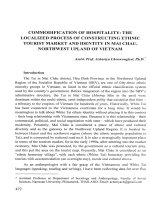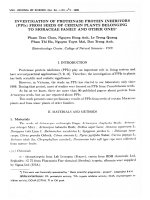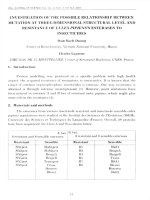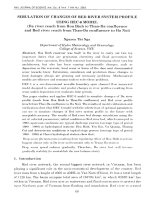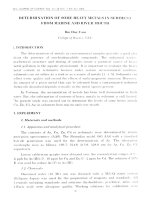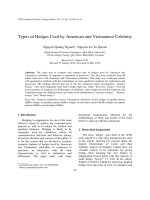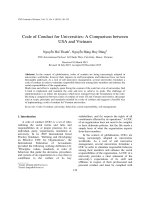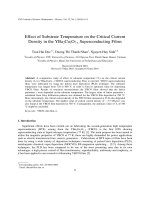DSpace at VNU: Effect of debranching and storage condition on crystallinity and functional properties of cassava and potato starches
Bạn đang xem bản rút gọn của tài liệu. Xem và tải ngay bản đầy đủ của tài liệu tại đây (412.28 KB, 8 trang )
Starch/Sta¨rke 2012, 00, 1–8
DOI 10.1002/star.201200039
1
RESEARCH ARTICLE
Effect of debranching and storage condition on
crystallinity and functional properties of
cassava and potato starches
Pham Van Hung1, Nguyen Thi Lan Phi2 and Tran Thi Vy Vy1
1
School of Biotechnology, International University, Vietnam National University in HoChiMinh City, Thu Duc District,
HoChiMinh City, Vietnam
2
Faculty of Chemical Engineering, HoChiMinh City University of Technology, HoChiMinh City, Vietnam
Debranching starch by pullulanase is considered to improve the RS content of starch which is
widely used to produce the starch-based foods with high-health benefit impacts. In this study,
the cassava and potato starches were debranched by pullulanase, followed by an autoclave
treatment and storage at À188C, 48C, or 258C to investigate their crystallinity and functional
properties. After debranching, the potato starch contained significantly higher CL (35.4
glucose units) than did the cassava starch (32.4 glucose units). The debranched cassava
and potato starches after retrogradation at the storage temperatures had a typical B-type
crystalline structure although the native cassava and potato starches exhibited the different
crystalline forms (A- and B-type, respectively). The RS contents of the debranched cassava
and potato starches significantly improved with higher RS content of the debranched potato
starch than that of the debranched cassava starch at the same storage condition. The storage
temperature significantly affected the RS formation of the debranched starches with the
highest RS content at storage temperature of À188C (35 and 48% for the debranched
cassava and potato starches, respectively). The debranched starches had significantly lower
viscosities and paste clarities but higher solubilities than did the native starches. As a result,
the debranched cassava and potato starches can be considered for use not only in functional
foods with enhanced health benefits but also in pharmaceutical and cosmetic industries.
Received: February 29, 2012
Revised: May 15, 2012
Accepted: May 31, 2012
Keywords:
Cassava starch / Crystallinity / Debranched starch / Functional properties / Potato starch
1
Introduction
AM and AP play an important role in starch characteristics
and are considered to have great impact on the formation
of texture and quality of starch-based food products [1]. AM
has been known as an essentially linear molecule joined by
a-(1,4)-linked D-glucopyranosyl bonds. It is now well rec-
Correspondence: Dr. Pham Van Hung, School of Biotechnology,
International University, Vietnam National University in HoChiMinh
City, Quarter 6, Linh Trung Ward, Thu Duc District, HoChiMinh City,
Vietnam
E-mail:
Fax: þ84-837-244-271
ß 2012 WILEY-VCH Verlag GmbH & Co. KGaA, Weinheim
ognized that a fraction of the AM molecules is slightly
branched by a-(1,6)-linkages [2, 3]. AM has a MW of
approximately 1 Â 105 to 1 Â 106 [4–6] with average
degree of polymerization (DPn) of 324–4920 [7–11]. In
contrast, AP is a very large, highly branched chain
molecule with a MW ranging from 1 Â 107 to 5.7 Â 109
and consists of a-(1,6)-linked D-glucopyranosyl units
attached to a-(1,4)-bonds [4–6, 12], in which the MW of
A-type APs varied to a larger range (7.0 Â 107 to
5.7 Â 109) than did that of B-type AP (1.7–3.4 Â 108)
[12]. These chains can be classified as either the
unbranched outermost chains (A) or the branched inner
Colour online: See the article online to view Figs. 2–4 in colour.
www.starch-journal.com
2
Starch/Sta¨rke 2012, 00, 1–8
P. V. Hung et al.
chains (B). In addition, there is a single chain (C) per
molecule which contains a sole reducing residue [13].
The B chains can be further divided in B1, B2, B3,
and B4 chains [8]. Branch points occur at approximately
every 20–25 glucopyranose residues. The DPn of AP molecules is typically within the range 1278–15 900 in which
high-AM starch showed lower DPn than the normal starch.
AP unit chains are relatively short compared to AM
molecules with typically ranging in 17–35 units long on
average.
The AP molecules are debranched by debranching
enzymes such as isoamylase or pullulanase which cleaves
a-(1,6)-linked D-glucopyranosyl points to form linear chains
[14, 15]. Shi et al. [16] reported that debranching of normal
starches releases a mixture of short and long linear chains
because both AM and AP in starch granules were
debranched, whereas debranching of wx starch releases
short linear side chains from AP. During retrogradation, AM
or the linear chains formed from debranched AP can form
double helices by hydrogen bonds between molecules
resulting in rigid gels called crystallinity. In nature, native
starch granules exhibited three main types of crystallinity,
the A-, B-, and C-type crystals, which can be monitored by
XRD analysis [17]. After debranching and crystallization,
the short-chain AM from debranched wx maize starch
formed a typical A-type crystalline structure when
debranched at high concentration (25% solids) [18],
whereas a dilute starting concentration (5% solids) led
to the formation of B-type crystalline structure [19]. The
debranching combined with physical treatment such as
ANN or heating and cooling cycles have been applied to
produce re-crystallized AM products, which had various
degrees of crystallinity and differing functional properties.
The debranched and recrystallined starch products were
reported to have high amounts of slowly digestible starch
(SDS) [20, 21] or RSs [22–24]. The solubility and waterbinding values of autoclaved and debranched samples of
the high-AM corn starches were higher than those of their
respective native starches, whereas autoclaving–storing
cycles after debranching caused decreases in peak,
breakdown, and final viscosity values [23]. Debranching
caused decreases in DSC peak temperature (Tp) and
increases in enthalpy of the high-AM corn starches [23].
However, Cai and Shi [19] reported that all three crystalline
short chain AMs (CSCA) from wx wheat, wx maize, and wx
potato starches had larger melting temperature range (80–
1408C) as compared to did the native starches (59–958C),
in which the CSCA from debranched wx potato starch
displayed a higher peak melting temperature (116.28C)
than those from debranched wx wheat (99.78C) and wx
maize (99.98C) starches. Although the relationship
between debranching and heat treatments and the formation of RSs and their functional properties from highAM starches [23], banana starch [24], or wx starches
ß 2012 WILEY-VCH Verlag GmbH & Co. KGaA, Weinheim
[18, 19] have been recently reported, the relationship
between the debranching and autoclave treatment with
different storage conditions and recrystallinity of
debranched starches as well as their functional properties
of cassava and potato starches has not been examined.
Therefore, the objective of this study is to investigate
crystallinity forms, functional properties, and RS contents
of debranched and recrystallined starches by debranching
cassava and potato starches using pullulanase, autoclave
treatment, and storage at different temperatures.
2
Materials and methods
2.1 Materials
Cassava (Manihot esculenta) and potato (Solanum tuberosum) grown in the southern part of Vietnam were used in
this study. Cassava and potato starches were isolated from
raw cassava roots and potato tubes at the Laboratory of
Applied Chemistry, International University, Vietnam. The
raw cassava roots and potato tubes were ground using an
engine-driven drum grater. Then the slurry was kept in a
solution of 4.5% NaHSO3 and passed through the sieves
(0.232 and 0.105 mm in aperture size). Resultant starches
were washed thoroughly in clean water to remove the
contaminant substances. Finally, the starch sediment
was recovered by centrifugation and dried in an oven at
408C to 10–11% moisture. The isolated starches were
deffated by hexane in a sohxlet system for 6 h before
using for debranching.
Pullulanase from Bacillus acidopullulyticus (!400 U/mL),
a-amylase from Aspergillus oryzae ($30 U/mg), and
amyloglucosidase from Aspergillus niger (!300 U/mL)
used in this study were purchased from Sigma–Aldrich
Co. (St. Louis, MO, USA). Other chemicals were purchased from Merck Co. (Darmstadt, Germany).
2.2 Debranching and storage of starches
Cassava and potato starches were debranched by pullulanase according to the method of Gonzalez-Soto et al.
[23] with slight modification as follows. The deffated starch
(10 g, db) was well mixed with 100 mL of acetate buffer
0.1 M (pH 5.2) and cooked in a boiling water bath (with
stirring) for 10 min with continuously stirring. The hot paste
was then autoclaved at 1218C for 30 min using an autoclave (model HV-85, Hirayama Manufacturer Corp.,
Japan). After autoclaving, the paste was cooled to 508C
and mixed with pullulanase (20 U/g starch). The mixture
was incubated with constant stirring for 24 h at 508C. After
24 h, the debranched starch gel was autoclaved at 1218C
for 30 min, cooled down and stored at 25, 4, or À188C for
another 24 h. The debranched starches were then dried at
www.starch-journal.com
Starch/Sta¨rke 2012, 00, 1–8
3
508C in an oven overnight and stored in closed glass
containers until further use.
2.3 Scanning electron microscopy (SEM) of
starches
Appearances of the native starch granules and crystals
of the debranched starches were observed by a SEM
(JEOL-JSM-6480LV, Tokyo, Japan). The preparation
and operation procedures were carried out as previously
described [25]. The samples were coated with Pt/Pd
and photographed at an accelerating potential of 10 kV.
2.4 Measurements of iodine absorption of
starches
Blue value of the native and debranched cassava and
potato starches were measured as previously described
[25]. Each starch was suspended in 1 M aqueous NaOH,
followed by heating in a boiling water bath with shaking.
An aliquot of the solution was mixed with iodine solution
(0.2% I2 and 2.01% KI) and then blue value of the iodine–
starch complex was measured at 680 nm. AM content of
the starches was calculated based on a calibration curve of
a mixture of AM and AP according to the equation:
AMð%Þ ¼ 110:786BV À 24:481;
R 2 ¼ 0:995
(1)
in which BV is the blue value of starches measured at
620 nm.
2.5 Determination of degree of polymerization
of debranched starches
The number–average degrees of polymerization ðDPn Þ
and the CL ðCLÞ after debranching were determined as
previously described by Hung and Morita [26]. DPn was
calculated as the difference between reducing residues
and total glucose concentration of the native starches,
whereas CL was calculated as the difference between
reducing residues and total glucose concentration of the
debranched starches. The average number of chains per
molecule was calculated as follows: NC ¼ ½ðDPn =CLÞ À 1.
2.6 X-ray diffraction pattern of starches
The crystalline structure of the native and debranched
cassava and potato starches was observed using an
X-ray diffractometer (Rigaku Co., Ltd., Rint-2000 type,
Tokyo, Japan) according to the operation described by
Hung and Morita [25]. The XRD system was operated at
40 kV and 80 mA and diffractograms of the starches were
recorded from 28 2u to 358 2u with a scanning speed of
88/min and scanning step of 0.028.
ß 2012 WILEY-VCH Verlag GmbH & Co. KGaA, Weinheim
2.7 Resistant starch determination
Resistant starch contents (%RS) of the native and
debranched cassava and potato starches were measured
based on the method of Englyst et al. [27] with moderate
modification as follows. Starch (1 g, db) was mixed with
25 mL of acetate buffer (pH 6.0) and then boiled for 30 min
in a water bath. After cooling to 378C, amylase solution
(7000 U/g starch) was added and the slurry was incubated
at 378C for 2 h. The suspension was then cooled to 258C
and adjusted to pH 4.5 before adding amyloglucosidase
(50 U/g starch). The mixture was then incubated at 608C for
30 min and then centrifuged (1500 Â g, 15 min) to obtain
the sediment. The sediment was washed with distilled water
for three times and then dried at 508C for 48 h. The %RS3
was calculated as weight of remained residue (db) compared to that of the initial sample. A blank with no starch was
used to minus the contamination of the enzymes.
2.8 Determination of pasting properties of
starches
Viscosity of the debranched starches was measured using
a Brookfield Viscometer LVDV-E according to the official
method described by the International Starch Institute
(ISI17, Science Park Aarhus, Denmark) with slight modification [28]. A starch slurry (2% starch) was cooked in a
boiling water bath for 15 min with continuously stirring and
additional 15 min without stirring. The paste was cooled
down to 508C and measured the viscosity in centipoises
(cP) at 508C at 50 rpm with spindle SC4-18.
Paste clarity of starches was determined according to
the method of Craig et al. [29]. Starch (0.05 g, db) was
suspended in 5 mL of distilled water in a glass-stoppered
tube. Then the slurry was heated at 958C for 30 min with
shaking every 5 min and cooled. The clarity of paste
was measured for transmittance (%T) using a spectrophotometer (UVD-2960, Labomed, USA) at 650 nm
against a water blank.
Solubility of starch (%) was determined as the method
previously described by Singh and Singh with slight
modification [30]. The starch (0.5 g, db) was suspended
in 50 mL of distilled water and shaked thoroughly for
30 min on a rotary shaker. The starch suspension was
centrifuged at 1200 Â g for 10 min. A 25 mL aliquot of
the supernatant was taken in a preweighed beaker and
dried in an air oven at 1108C for 4 h. The cold water solubility
was calculated as degree of solubility (%) ¼ grams of solid
in supernatant  2/grams of samples  100.
2.9 Statistical analysis
Data were expressed as the mean values Æ SE of the
three separate determinations. Comparison of means
www.starch-journal.com
4
P. V. Hung et al.
was performed by one-way analysis of variance (ANOVA)
followed by Duncan’s multiple comparison tests ( p<0.05)
using SPSS version 16 (SPSS Inc., Chicago, IL) system.
3
Results and discussion
3.1 SEM of native and debranched starches
Figure 1 shows the granular appearances of the native
cassava and potato starches and their crystalline forms
after debranching. Native cassava and potato starches
had naturally granular structures with smooth surfaces.
Potato starch had oval-shaped granules, whereas cassava
starch had both spherical- and polygonal-shaped granules, which are smaller than those of potato starch.
After debranching, both debranched cassava and potato
starches formed crystalline particles. The crystalline
particles of the dried debranched starches were the same
for both cassava and potato starches and their sizes were
dependant on the sizes of sieves. Thus, the treatment of
the native starches by debranching and autoclaving
caused the granular structure of starches broken down
to form short-chain linear AMs which were aggregated and
Starch/Sta¨rke 2012, 00, 1–8
developed crystalline particles. Gonzalez-Soto et al. [23]
reported that the samples stored at 48C for 24 h observed
a more compact structure than samples stored at higher
temperatures. The different structures of the debranched
starches stored at different temperatures were due to the
crystalline character present in those samples which might
be associated to a higher level of cavities or channels in the
matrix of starches stored at the high temperature in contrast with the topological structure of starches stored at
lower temperatures. In this study, the debranched starches
stored at 258C for 24 h did not show any cavities or channels in the matrix of crystalline particles.
3.2 Amylose content and degree of
polymerization of debranched starches
Amylose content of native potato starch was significantly
higher than that of native cassava starch resulting in the
higher blue value of iodine–AM complex of potato starch
than that of cassava starch (Table 1). The CLs of the
debranched cassava and potato starches were 32.4 and
35.4 glucose units, respectively, whereas the average
degree of polymerization were 1400 and 1520 glucose
units for native cassava and potato starches, respectively.
Figure 1. SEM of native and debranched cassava and potato starches. NCS, native cassava starch; DCS, debranched
cassava starch; NPS, native potato starch; DPS, debranched potato starch.
ß 2012 WILEY-VCH Verlag GmbH & Co. KGaA, Weinheim
www.starch-journal.com
Starch/Sta¨rke 2012, 00, 1–8
5
Table 1. Structural characteristics of native and debranched cassava and potato starchesa),b)
Structural indexes
Starch
AM content (%)
Blue value
DPn
CL
NC
Cassava
Potato
17.0 Æ 1.0a
27.4 Æ 3.7b
0.337 Æ 0.010c
0.460 Æ 0.014d
1400 Æ 50a
1520 Æ 60b
32.4 Æ 0.1b
35.4 Æ 0.2a
40.8 Æ 0.2a
40.6 Æ 0.3b
a) DPn , average degree of polymerization; CL, average chain length; NC, number of chain.
b) Values with the same letter in the same column are not significantly different.
Thus, AP molecules of the native starches were mostly
debranched by pullulanase into the short-chain molecules.
Morrison and Karkalas [30] reported that the CLs of AMs
fractionated from cassava and potato starches were 340
and 670 glucose units, respectively, which were significantly higher than those of APs of cassava and potato
starches (21.2 and 22.0–23.9 glucose units, respectively).
These results indicate that the CLs of both AM and AP of the
cassava starch were lower than those of the potato starch,
which is consistent with the findings in this study. Cai and Shi
[19] reported that the CLs of the debranched wx wheat, wx
maize, and wx potato starches were 28.1, 29.2, and 35.5
glucose units, respectively, after debranching with 1% of
isoamylase (1.41 Â 106 IAU/g). Thus, the debranched cassava and potato starches had significantly higher CLs than
did the wx wheat and wx maize starches. Although the
minimum chain length required to form starch double helices is 10 [31], the difference in the CL led to the differences
in yield of crystallized product, peak melting temperature,
and RS content of the debranched starches [19].
3.3 X-ray diffraction patterns of starches
The X-ray diffraction patterns of the native and
debranched cassava and potato starches are shown in
Fig. 2. The native cassava starch had the typical A-type
crystalline structure with the main peaks numbered 2a, 2b,
3b, 4a, 4b, 5a, 6a, and 7, whereas the native potato starch
had the typical B-type crystalline structure with the main
peaks numbered 1, 3a, 3b, 4a, 5a, 6a, 6b, and 7 as
described by Zobel et al. [17]. After debranching, all
debranched starches showed the B-type crystalline structures with stronger peaks than did the native starches.
However, it is not clear difference in degree of crystallinity
of the debranched starches stored at different temperature
both for cassava and potato starches. These results are
consistent with the previous studies [19, 23], who reported
that the typical B-type structure was observed for all
debranched starches even though the corresponding
native starch had the A-type structure [19] or the
C-type structure [23]. However, a dual-stage crystallization
phenomenon, B-type crystallization appeared during
the first 8 h of incubation, followed by A-type crystallization
between 16 and 24 h, was observed when debranched
at 25% solids and crystallized at 508C [18]. These
results indicate that debranching of starch at low concentration (5 or 10% solids) or short time at higher concentration of starch produced a B-type crystalline form,
otherwise the formation of A-type crystallites was
observed.
Figure 2. XRD patterns of native and debranched cassava (A) and potato (B) starches at different storage conditions.
NCS, native cassava starch; DCS þ 25, DCS þ 4, and DCS À 18, debranched cassava starches stored at þ258C,
þ48C, and À188C, respectively; NPS, native potato starch; DPS þ 25, DPS þ 4 and DPS À 18, debranched potato starches
stored at þ258C, þ48C, and À188C, respectively.
ß 2012 WILEY-VCH Verlag GmbH & Co. KGaA, Weinheim
www.starch-journal.com
6
Starch/Sta¨rke 2012, 00, 1–8
P. V. Hung et al.
3.4 Resistant starch contents of debranched
starches
Resistant starch (RS3) content (%, db) of native and
debranched cassava and potato starches at different storage conditions are shown in Fig. 3. According to Englyst
et al. [27], RS of the native starch was classified as RS2,
whereas the RS of the cooked and retrograded starch was
RS3. Therefore, the RS of the debranched starches in this
study was determined as RS3. After debranching and
storing at different temperatures for 24 h, RS3 contents
of the starches was significantly increased as compared to
those of the native starches. This result agreed with the
previous studies on formation of RS by debranching starch
using pullulanase or isoamylase [18, 19, 23, 24]. Thus,
the aggregation and arrangement of double helices of the
short chain AMs in the debranched starches formed the
new crystalline structure (B-type) resulting in the increased
RS content. The storage of sample at different temperatures after autoclaved cycle showed significantly influence
in the RS3 content of the debranched starch in this study.
The debranched starch stored at À188C for 24 h had the
highest RS3 content, followed by that stored at 48C and
that stored at 258C. The different RS3 contents might be
due to the starch pastes stored at À188C rapidly retrogradated than those stored at 4 and 258C. This result
indicates that the speed of retrogradation significantly
affects the crystalline structure of double helices and
RS content of the short chain AMs. In addition, the effect
of storage temperature on RS formation was also reported
by Gonzalez-Soto et al. [23], who stated that when starchy
material was stored at high temperatures (i.e., 608C)
and the Tg was lower than the storage temperature, the
material was in a rubbery state resulting in a slow retrogradation process and low-RS content.
In the native forms, the potato starch with the typical
B-type crystals had the higher RS2 content as compared to
60
3.5 Viscosity of debranched starches
Viscosities (cP) of the native and debranched cassava and
potato starches at different storage conditions are given in
Table 2. In the native forms, the starch pastes made from
the cooked cassava and potato starches were too viscous
which were hardly measured by the Brookfield at high
concentration (>2%) according to the method described
above. At 2% of starch concentration, the viscosities of
native cassava and potato starches were 45.7 and 45.9 cP,
respectively. After debranching, the viscosities of pastes
from the cooked debranched cassava and potato starches
significantly reduced because of low-MWs of the linear
chains presented in those starches. The viscosities of
the debranched starches at different storage condition
Table 2. Viscosities (cP) of native and debranched
cassava and potato starches at different storage
conditionsa),b)
50
RS content (%,db)
the starches having the A-type crystallinity [18, 25]. The
result in this study also shows that the native potato starch
after cooking still contained higher RS content than did
the cassava starch. Moreover, the RS3 content of the
debranched potato starch was significantly higher than
that of the debranched cassava starch at the same storage
condition. The differences might be due to the chain length
distribution and degree of crystalline structure of the
short chain AMs obtained by debranching of starches.
The debranched potato starch with significantly higher
CL (35.4 glucose units) formed double helices with more
dense crystalline structure resulting in more resistance to
enzyme digestion as compared to the debranched cassava starch having the CL about 32.4 glucose units. This
result is consistent with other studies on wx starches [19].
The highest RS3 contents obtained in this study were
35 and 48% for the debranched cassava and potato
starches stored at À188C, respectively, suggesting that
the debranching and autoclaving process followed by
storage at À188C is preferred to prepare products with
high-RS content.
40
Cassava
Potato
30
20
10
0
NS
DS+25
DS+4
Sample
Cassava
NS
DSþ25
DSþ4
DS-18
45.7
0.6
0.7
0.6
Æ
Æ
Æ
Æ
0.2b
0.1a
0.1a
0.1a
Potato
45.9
1.8
1.7
1.6
Æ
Æ
Æ
Æ
0.2b
0.1a
0.2a
0.1a
DS-18
o
Storage temperature ( C)
Figure 3. RS content (%, db) of native and debranched
cassava and potato starches at different storage conditions. NS, native starch; DS þ 25, DS þ 4, and DS À 18,
debranched starches stored at þ258C, þ48C, and À188C.
ß 2012 WILEY-VCH Verlag GmbH & Co. KGaA, Weinheim
a) Values with the same letter in the same column are not
significantly different.
b) NS, native starch; DS þ 25, DS þ 4 and DS À 18,
debranched starches stored at þ258C, þ48C, and
À188C.
www.starch-journal.com
Starch/Sta¨rke 2012, 00, 1–8
7
were not significantly different. However, the viscosities of
the debranched cassava starches were significantly lower
than those of the debranched potato starches at the same
storage conditions. This result might be due to the lower
CL of the debranched cassava starch which reduced the
viscosity as compared to that of the debranched potato
starch.
3.6 Paste clarity of native and debranched
starches
Figure 4 shows the results of paste clarity (%T) of native
and debranched cassava and potato starches at different
storage conditions. Transparences of the pastes from the
debranched starches were significantly lower than those of
the native starches. The remarkable changes from the
starch polymer solution at the beginning of debranching
to the cloudy slurry after 24 h of crystallization at 508C
were also observed by Cai et al. [18]. These results are due
to the small and fine crystallites formed by the double
helices of the short chain length of AMs of the debranched
starches as compared to the high molecules of AM and AP
of the native starches. In this study, the lowest transparences of the pastes of the debranched starches stored at
48C were observed among the tested samples because
the smallest and finest crystallites were formed at this
temperature [29].
3.7 Solubility (%) of native and debranched
starches
Solubility of native and debranched cassava and potato
starches were determined by stirring the starches in
excess water at ambient temperature and the results
Table 3. Solubility (%) of native and debranched cassava
and potato starches at different storage
conditionsa),b)
Sample
Cassava
NS
DSþ25
DSþ4
DS-18
0.5
12.1
12.6
12.2
Æ
Æ
Æ
Æ
0.0a
0.5b
0.5b
0.6b
Potato
0.5
9.8
10.2
9.9
Æ
Æ
Æ
Æ
0.0a
0.3b
0.3b
0.4b
a) The same letter in the same column is not significantly
different.
b) NS, native starch; DS þ 25, DS þ 4 and DS À 18,
debranched starches stored at þ258C, þ48C, and
À188C.
are shown in Table 3. The native starch hardly dissolved
in the water, whereas the debranched starches containing
the short-chain molecules had higher solubilities. The solubilities of the debranched cassava starch (12.1–12.6%)
were significantly higher than those of the debranched
potato starch (9.8–10.2%) because the debranched cassava starch had lower short-chain molecules as compared
to the debranched potato starch. The solubilities of the
debranched starches stored at different temperatures
were not significantly different indicating that the solubilities of the debranched starches were dependant on the
chain length distribution rather than the form of crystallites.
As a result, the debranched starches with high-RS
contents and low viscosities and solubilities are considered
to be not only used in functional foods with enhanced
health benefits but also used in pharmaceutical and cosmetic industries.
4
Conclusions
80
Transmittance (%)
70
60
50
40
30
20
10
Potato
0
NS
DS+25
Cassava
DS+4
DS-18
o
Storage temperature ( C)
Figure 4. Paste clarity (%T) of native and debranched
cassava and potato starches at different storage conditions. NS, native starch; DS þ 25, DS þ 4, and DS À 18,
debranched starches stored at þ258C, þ48C, and À188C.
ß 2012 WILEY-VCH Verlag GmbH & Co. KGaA, Weinheim
The crystallinity and functional properties of cassava and
potato starches after debranching by pullulanase and autoclave treatment with different storage temperatures are
successfully investigated in this study. The debranched
potato starch had higher CL and RS content than did
the debranched cassava starch. Both debranched cassava and potato starches exhibited the typical B-type
structure with reduced viscosity and paste clarity and
increased solubility as compared to the native starches.
The storage temperature did not affect the crystallinity and
functional properties of the debranched starches but significantly influenced in RS formation. The RS contents of
both cassava and potato debranched starches were the
highest at storage temperature of À188C. As a result, the
potato starch is considered to be a good starting material
to produce high amount of RS by debranching and autowww.starch-journal.com
8
P. V. Hung et al.
clave treatment. However, both debranched cassava and
potato starches can be used for functional food processing
and pharmaceutical and cosmetic industries.
The authors thank the National Foundation for Science
and Technology Development, Vietnam (NAFOSTED),
research grant no. 106.99-2010.66 for the financial
support.
The authors have declared no conflict of interest.
5 References
[1] Hung, P. V., in: Papadopoulos, K. N. (Ed.), Food Chemistry
Research Developments, Nova Science Publishers, Inc.,
New York 2008, pp. 141–166.
[2] Hizukuri, S., Takeda, Y., Yasuda, M., Multi-branched nature of
amylose and the action of debranching enzymes. Carbohydr.
Res. 1981, 95, 205–213.
[3] Shibanuma, K., Takeda, Y., Hizukuri, S., Shibata, S.,
Molecular-structures of some wheat starches. Carbohydr.
Polym. 1994, 25, 111–116.
[4] Biliaderis, C. G., in: Walter, R. H. (Ed.), Polysaccharide
Association Structures in Foods, Marcel Dekker, New York
1998, pp. 57–168.
[5] Buleon, A., Colonna, P., Planchot, V., Ball, S., Starch granules: Structure and biosynthesis. Int. J. Biol. Macromol.
1998, 23, 85–112.
[6] Mua, J. P., Jackson, D. S., Fine structure of corn amylose and
amylopectin fractions with various molecular weights.
J. Agric. Food Chem. 1997, 45, 3840–3847.
[7] Hizukuri, S., Relationship between the distribution of the
chain length of amylopectin and the crystalline structure of
starch granules. Carbohydr. Res. 1985, 141, 295–305.
[8] Hizukuri, S., Polymodal distribution of the chain lengths of
amylopectin and its significance. Carbohydr. Res. 1986, 147,
342–347.
[9] Hung, P. V., Morita, N., Chemical compositions, fine structure
and physicochemical properties of kudzu (Pueraria lobata)
starches. Food Chem. 2007, 105, 749–755.
[10] Hung, P. V., Maeda, T., Miskelly, D., Tsumori, R., Morita, N.,
Physicochemical characteristics and fine structure of highamylose wheat starches isolated from Australian wheat cultivars. Carbohydr. Polym. 2008, 71, 656–663.
[11] Takeda, Y., Shibahara, S., Hanashiro, J., Examination of the
structure of amylopectin molecules by fluorescent labeling.
Carbohydr. Res. 2003, 338, 471–475.
Starch/Sta¨rke 2012, 00, 1–8
[14] Hizukuri, S., Abe, J., Hanashiro, I., in: Eliasson, A-.C. (Ed.),
Carbohydrates in Food, 2nd edn., Taylor & Francis Group,
Boca Raton, FL 2006, pp. 305–391.
[15] Manners, D. J., Recent developments in our understanding
of amylopectin structure. Carbohydr. Polym. 1989, 11,
87–112.
[16] Shi, Y.-C., Capitani, T., Trzasko, P., Jeffcoat, R., Molecular
structure of a low amylopectin starch and other high-amylose
maize starches. J. Cereal Sci. 1998, 27, 289–299.
[17] Zobel, H. F., Starch crystal transformations and their industrial importance. Starch/Sta¨rke 1988, 40, 1–7.
[18] Cai, L., Shi, Y.-C., Rong, L., Hsiao, B. S., Debranching and
crystallization of waxy maize starch in relation to enzyme
digestibility. Carbohydr. Polym. 2010, 81, 385–393.
[19] Cai, L., Shi, Y.-C., Structure and digestibility of crystalline
short-chain amylase from debranched waxy wheat, waxy
maize, and waxy potato starches. Carbohydr. Polym.
2010, 79, 1117–1123.
[20] Shi, Y.-C., Shi, Y.-C., Cui, X. M., Birkett, A. G., Thatcher, M.,
Slowly digestible starch product. US patent 6890571, 2005.
[21] Shi, Y.-C., Cui, X. M., Birkett, A. G., Thatcher, M., Slowly
digestible starch product. US patent 6929817, 2005.
[22] Berry, C. S., Resistant starch-formation and measurement of
starch that survives exhaustive digestion with amylolytic
enzymes during the determination of dietary fiber.
J. Cereal Sci. 1986, 4, 301–314.
[23] Ozturk, S., Koksel, H., Kahraman, K., Ng, P. K. W., Effect of
debranching and heat treatments on formation and functional
properties of resistant starch from high-amylose corn
starches. Eur. Food Res. Technol. 2009, 229, 115–125.
[24] Gonzalez-Soto, R. A., Mora-Escobedo, R., HernandezSanchez, H., Sanchez-Rivera, M., Bello-Perez, L. A., The
influence of time and storage temperature on resistant starch
formation from autoclaved debranched banana starch. Food
Res. Int. 2007, 40, 304–310.
[25] Hung, P. V., Morita, N., Physicochemical properties and enzymatic digestibility of starch from edible canna (Canna
edulis) grown in Vietnam. Carbohydr. Polym. 2005, 61,
314–321.
[26] Hung, P. V., Morita, N., Chemical compositions, fine structure
physicochemical properties of kudzu (Pueraria lobata)
starches from different regions. Food Chem. 2007, 105,
749–755.
[27] Englyst, H. N., Kingman, S. M., Cummings, J. H.,
Classification measurement of nutritionally important starch
fractions. Eur. J. Clin. Nutr. 1992, 46, S33–S50.
[28] International Starch Institute, Laboratory Method. Method
ISI 17. Determination of Viscosity of Starch by Brookfield,
Science Park Aarhus, Denmark 2002.
[29] Craig, S. A. S., Maningat, C. C., Seib, P. A., Hoseney,
R. C., Starch paste clarity. Cereal Chem. 1989, 66,
173–182.
[12] Yoo, S.-H., Jane, J.-L., Molecular weights and gyration radii of
amylopectins determined by high-performance size-exclusion chromatography equipped with multi-angle laser-light
scattering and refractive index detectors. Carbohydr.
Polym. 2002, 49, 307–314.
[30] Morrison, W. R., Karkalas, J., in: Dey, P. M. (Ed.), Methods in
Plant Biochemistry, Vol. 2, Academic Press, London 1990,
pp. 323–352.
[13] Peat, S., Whelan, W. J., Thomas, G. J., The enzymic synthesis and degradation of starch. XXII. Evidence of multiple
branching in waxy maize starch. J. Chem. Soc. 1956, 1956,
3025–3030.
[31] Gidley, M. J., Bulpin, P. V., Crystallization of malto-oligosaccharides as models of the crystalline forms of starch:
Minimum chain-length requirement for the formation of
double helices. Carbohydr. Res. 1987, 161, 291–300.
ß 2012 WILEY-VCH Verlag GmbH & Co. KGaA, Weinheim
www.starch-journal.com

